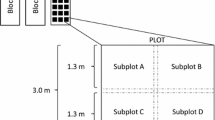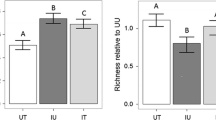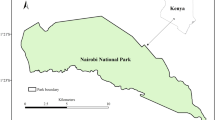Abstract
Invasions of non-native species are considered to have significant impacts on native species, but few studies have quantified the direct effects of invasions on native community structure and composition. Many studies on the effects of invasions fail to distinguish between (1) differential responses of native and non-native species to environmental conditions, and (2) direct impacts of invasions on native communities. In particular, invasions may alter community assembly following disturbance and prevent recolonization of native species. To determine if invasions directly impact native communities, we established 32 experimental plots (27.5 m2) and seeded them with 12 native species. Then, we added seed of a non-native invasive grass (Microstegium vimineum) to half of the plots and compared native plant community responses between control and invaded plots. Invasion reduced native biomass by 46, 64, and 58%, respectively, over three growing seasons. After the second year of the experiment, invaded plots had 43% lower species richness and 38% lower diversity as calculated from the Shannon index. Nonmetric multidimensional scaling ordination showed a significant divergence in composition between invaded and control plots. Further, there was a strong negative relationship between invader and native plant biomass, signifying that native plants are more strongly suppressed in densely invaded areas. Our results show that a non-native invasive plant inhibits native species establishment and growth following disturbance and that native species do not gain competitive dominance after multiple growing seasons. Thus, plant invaders can alter the structure of native plant communities and reduce the success of restoration efforts.






Similar content being viewed by others
References
Aarssen LW, Epp GA (1990) Neighbor manipulations in natural vegetation—a review. J Veg Sci 1:13–30
Barden LS (1987) Invasion of Microstegium vimineum (Poaceae), an exotic, annual, shade-tolerant, C-4 grass, into a North-Carolina floodplain. Am Midl Nat 118:40–45
Biggerstaff MS, Beck CW (2007) Effects of method of English ivy removal and seed addition on regeneration of vegetation in a southeastern piedmont forest. Am Midl Nat 158:206–220
Bunge J, Fitzpatrick M (1993) Estimating the number of species—a review. J Am Stat Assoc 88:364–373
Byers JE, Reichard S, Randall JM et al (2002) Directing research to reduce the impacts of nonindigenous species. Conserv Biol 16:630–640
Callaway RM, DeLuca TH, Belliveau WM (1999) Biological-control herbivores may increase competitive ability of the noxious weed Centaurea maculosa. Ecology 80:1196–1201
Cole PG, Weltzin JF (2004) Environmental correlates of the distribution and abundance of Microstegium vimineum, in east Tennessee. Southeast Nat 3:545–562
Colwell RK (2005) EstimateS: statistical estimation of species richness and shared species from samples. Version 7.5. User's Guide and application published at: http://purl.oclc.org/estimates
Colwell RK, Mao CX, Chang J (2004) Interpolating, extrapolating, and comparing incidence-based species accumulation curves. Ecology 85:2717–2727
Corbin JD, D’Antonio CM (2004) Competition between native perennial and exotic annual grasses: implications for an historical invasion. Ecology 85:1273–1283
Davis MA, Bier L, Bushelle E et al (2005) Non-indigenous grasses impede woody succession. Plant Ecol 178:249–264
Dukes JS (2001) Biodiversity and invasibility in grassland microcosms. Oecologia 126:563–568
Ehrenfeld JG, Kourtev P, Huang WZ (2001) Changes in soil functions following invasions of exotic understory plants in deciduous forests. Ecol Appl 11:1287–1300
Fairbrothers DE, Gray JR (1972) Microstegium vimineum (Trin.) A. Camus (Gramineae) in the United States. J Torrey Bot Soc 99(9):7–100
Flory SL (2009) Management of Microstegium vimineum invasions and recovery of resident plant communities. Restoration Ecology, Online early
Flory SL, Clay K (2009) Invasive plant removal method determines native plant community responses. J Appl Ecol 46:434–442
Flory SL, Rudgers JA, Clay K (2007) Experimental light treatments affect invasion success and the impact of Microstegium vimineum on the resident community. Nat Areas J 27:124–132
Glasgow LS, Matlack GR (2007) The effects of prescribed burning and canopy openness on establishment of two non-native plant species in a deciduous forest, southeast Ohio, USA. For Ecol Manag 238:319–329
Gorchov DL, Trisel DE (2003) Competitive effects of the invasive shrub, Lonicera maackii (Rupr.) Herder (Caprifoliaceae), on the growth and survival of native tree seedlings. Plant Ecol 166:13–24
Gotelli NJ, Colwell RK (2001) Quantifying biodiversity: procedures and pitfalls in the measurement and comparison of species richness. Ecol Lett 4:379–391
Hamilton JG, Holzapfel C, Mahall BE (1999) Coexistence and interference between a native perennial grass and non-native annual grasses in California. Oecologia 121:518–526
Hill MO (1973) Diversity and evenness—unifying notation and its consequences. Ecology 54:427–432
Hobbs RJ, Huenneke LF (1992) Disturbance, diversity, and invasion—implications for conservation. Conserv Biol 6:324–337
Holmes PM, Cowling RM (1997) The effects of invasion by Acacia saligna on the guild structure and regeneration capabilities of South African fynbos shrublands. J Appl Ecol 34:317–332
Jost L (2006) Entropy and diversity. Oikos 113:363–375
Krebs CJ (1989) Ecological methodology. Harper Row, New York
Leicht SA, Silander JA, Greenwood K (2005) Assessing the competitive ability of Japanese stilt grass, Microstegium vimineum (Trin.) A. Camus. J Torrey Bot Soc 132:573–580
Lenz TI, Moyle-Croft JL, Facelli JM (2003) Direct and indirect effects of exotic annual grasses on species composition of a South Australian grassland. Austral Ecol 28:23–32
Levine JM, Vila M, D’Antonio CM et al (2003) Mechanisms underlying the impacts of exotic plant invasions. Proc R Soc Lond B Biol Sci 270:775–781
Lonsdale WM (1999) Global patterns of plant invasions and the concept of invasibility. Ecology 80:1522–1536
MacArthur RH (1965) Patterns of species diversity. Biol Rev Camb Philos Soc 40:510–533
MacDougall AS, Turkington R (2005) Are invasive species the drivers or passengers of change in degraded ecosystems? Ecology 86:42–55
Mack RN, Simberloff D, Lonsdale WM et al (2000) Biotic invasions: causes, epidemiology, global consequences, and control. Ecol Appl 10:689–710
Magurran AE (1988) Ecological diversity and its measurement. Princeton University Press, Princeton
Maron JL, Marler M (2008) Field-based competitive impacts between invaders and natives at varying resource supply. J Ecol 96:1187–1197
Marshall JM, Buckley DS (2008) Influence of litter removal and mineral soil disturbance on the spread of an invasive grass in a Central Hardwood forest. Biol Invasions 10:531–538
McCune B, Grace JB (2002) Analysis of ecological communities. MjM Software Design, Gleneden Beach, ORUSA
McCune B, Mefford MJ (1999) PC-ORD. Multivariate analysis of ecological data. Version 4. MjM Software Design, Gleneden Beach, OR
McLellan AJ, Fitter AH, Law R (1995) On decaying roots, mycorrhizal colonization and the design of removal experiments. J Ecol 83:225–230
NOAA and NCDC (2008) National Oceanic and Atmospheric Administration, National Climate Data Center
Oswalt CM, Oswalt SN (2007) Winter litter disturbance facilitates the spread of the nonnative invasive grass Microstegium vimineum (Trin.) A. Camus. For Ecol Manag 249(19):9–203
Oswalt CM, Oswalt SN, Clatterbuck WK (2007) Effects of Microstegium vimineum (Trin.) A. Camus on native woody species density and diversity in a productive mixed-hardwood forest in Tennessee. For Ecol Manag 242(72):7–732
Overlease W, Overlease E (2007) 100 Years of change in the distribution of common Indiana weeds. Purdue University Press, West Lafayette
Parker IM, Reichard S (1998) Critical issues in invasion biology for conservation science. In: Fiedler PL, Kareiva P (eds) Conservation biology: for the coming decade. Chapman and Hall, New York, pp 283–305
Parker IM, Simberloff D, Lonsdale WM et al (1999) Impact: toward a framework for understanding the ecological effects of invaders. Biol Invasions 1:3–19
Pielou EC (1975) Ecological diversity. Wiley, New York
Pimentel D, Lach L, Zuniga R et al (2000) Environmental and economic costs of nonindigenous species in the United States. Bioscience 50:53–65
Redman DE (1995) Distribution and habitat types for Nepal Microstegium [(Microstegium vimineum (Trin.) Camus] in Maryland and the District of Columbia. Castenea 60:270–275
SAS Institute Inc (2002) Cary, NC, USA
Seabloom EW, Harpole WS, Reichman OJ et al (2003) Invasion, competitive dominance, and resource use by exotic and native California grassland species. Proc Natl Acad Sci USA 100:13384–13389
USDA and NRCS (2005) The PLANTS database. Data compiled from various sources by Mark W. Skinner. Version 3.5. National Plant Data Center, Baton Rouge, LA 70874-4490 USA
Zimmerman GM, Goetz H, Mielke PW (1985) Use of an improved statistical method for group comparisons to study effects of prairie fire. Ecology 66:606–611
Acknowledgments
We thank the many undergraduate students who assisted with this project and those who reviewed earlier drafts of this manuscript. This project was financially supported by The Nature Conservancy, a partnership between Indiana University and the USDA Forest Service, Hoosier National Forest, and the Joint Fire Science Program.
Author information
Authors and Affiliations
Corresponding author
Rights and permissions
About this article
Cite this article
Flory, S.L., Clay, K. Non-native grass invasion alters native plant composition in experimental communities. Biol Invasions 12, 1285–1294 (2010). https://doi.org/10.1007/s10530-009-9546-9
Received:
Accepted:
Published:
Issue Date:
DOI: https://doi.org/10.1007/s10530-009-9546-9




